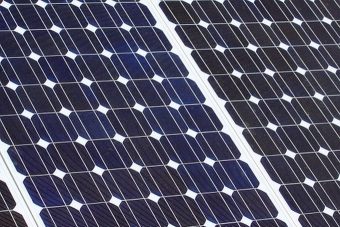
South Korean scientists have created solar PV cells that are 1 micrometer thick, hundreds of times thinner than most PV and half again as thin as other kinds of thin-film PV. (The research is in a paper just published in Applied Physics Letters.)
The cells are made with gallium arsenide as the semiconductor, “cold welded” directly onto a metal substrate, with no adhesive to make them thicker. Remarkably, they produce roughly as much power as thicker PV cells, though in testing, “the cells could wrap around a radius as small as 1.4 millimeters.”
With cells this thin, solar PV can be integrated in all sorts of “wearables” — clothes, glasses, hats, or backpacks with solar cells integrated, continuously feeding power to our portable electronics. More to the point, PV could be integrated into just about anything.
This isn’t the thinnest solar cell ever, either. Back in February, MIT researchers madesolar cells so small and light they could sit atop a soap bubble without popping it.
Vladimir Bulović, MIT’s associate dean for innovation and the Fariborz Maseeh (1990) Professor of Emerging Technology, says the key to the new approach is to make the solar cell, the substrate that supports it, and a protective overcoating to shield it from the environment, all in one process. The substrate is made in place and never needs to be handled, cleaned, or removed from the vacuum during fabrication, thus minimizing exposure to dust or other contaminants that could degrade the cell’s performance.
The process takes place in a vacuum chamber at room temperature, without the solvents and high temperatures required to make conventional PV. Researchers say the same fabrication process could work with a number of different materials, including quantum dots or perovskites, yielding solar cells small and transparent enough to be embedded in windows or building materials.
Now, all these lab breakthroughs are just that: lab breakthroughs. It’s a long road from the lab to a commercial product. Plenty could go wrong in between.
But the trends in solar innovation are clear. Cells are getting smaller and smaller, and more and more flexible, using new fabrication techniques that are less and less resource-intensive.
It’s all super expensive now, and probably will be for a while. Eventually, though, these new methods will find their way into markets and start getting scaled up. With scale, costs come down.
PV is different from any other energy technology. It can change the way we view power, from something we generate at a specific location to something we harvest, everywhere. Sufficiently cheap, small, and flexible solar cells could be integrated into our building materials, streets, bridges, parking lots, vehicles, clothes, even our skin.
These tiny solar cells won’t produce much power individually, but what they lack in energy density, they will make up for in ubiquity. They will be everywhere. And as solar diffuses into infrastructure, so too will energy storage and management.
Eventually, the entire built environment of human civilization will become one giant energy harvester and manager. The power system will not be something overlaid onto infrastructure but something that is part and parcel of infrastructure, something infrastructure just does, automatically. Most or all of the power urbanites need will simply exist in a seamless web, all around them.
Photo: treehugger.com
Source: vox.com

